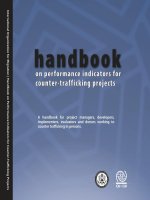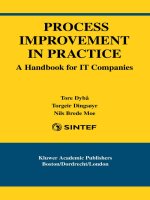process improvement in practice a handbook for it companies
Bạn đang xem bản rút gọn của tài liệu. Xem và tải ngay bản đầy đủ của tài liệu tại đây (4.65 MB, 123 trang )
PROCESS IMPROVEMENT IN
PRACTICE
A Handbook for IT Companies
THE KLUWER INTERNATIONAL SERIES IN
SOFTWARE ENGINEERING
Series Editor:
Victor R. Basili
University of Maryland
College Park, MD 20742
Also in the Series:
IDENTIFYING RELEVANT INFORMATION FOR TESTING TECHNIQUE
SELECTION by Sira Vegas, Sira Vegas, Victor Basili; ISBN: 1-4020-7435-2
MULTIMEDIA SOFTWARE ENGINEERING by Shi-Kuo Chang; ISBN 0-7923-7736-2
EXPERIMENTATION IN SOFTWARE ENGINEERING: AN INTRODUCTION by Claes
Wohlin, Per Runeson, Martin Höst, Magnus C. Ohlsson, Björn Regnell, Anders
Wesslén; ISBN: 0-7923-8682-5
NON-FUNCTIONAL REQUIREMENTS IN SOFTWARE ENGINEERING by Lawrence
Chung, Brian A. Nixon, Eric Yu and John Mylopoulos; ISBN: 0-7923-8666-3
SOFTWARE DEFECT MODELING by Kai-Yuan Cai; ISBN: 0-7923-8259-5
CONSTRAINT-BASED DESIGN RECOVERY FOR SOFTWARE REENGINEERING:
Theory and Experiments by Steven G. Woods, Alexander E. Quilici and Qiang Yang
;
ISBN: 0-7923-8067-3
TOOLS AND ENVIRONMENTS FOR PARALLEL AND DISTRIBUTED SYSTEMS by
Amr Zaky and Ted Lewis; ISBN: 0-7923-9675-8
FORMAL SPECIFICATION TECHNIQUES FOR ENGINEERING MODULAR C
PROGRAMS by TAN Yang Meng; ISBN: 0-7923-9653-7
The Kluwer International Series in Software Engineering addresses the following
goals:
To coherently and consistently present important research topics and their
application(s).
To present evolved concepts in one place as a coherent whole, updating early
versions of the ideas and notations.
To provide publications which will be used as the ultimate reference on the
topic by experts in the area.
With the dynamic growth evident in this field and the need to communicate findings, this
series provides a forum for information targeted toward Software Engineers.
PROCESS IMPROVEMENT IN
PRACTICE
A Handbook for IT Companies
by
Tore Dybå
Torgeir Dingsøyr
Nils Brede Moe
SINTEF Information and Communication Technology
Trondheim, Norway
KLUWER ACADEMIC PUBLISHERS
NEW YORK, BOSTON, DORDRECHT, LONDON, MOSCOW
eBook ISBN: 1-4020-7879-X
Print ISBN: 1-4020-7869-2
©2004 Kluwer Academic Publishers
New York, Boston, Dordrecht, London, Moscow
Print ©2004 Kluwer Academic Publishers
Boston
All rights reserved
No part of this eBook may be reproduced or transmitted in any form or by any means, electronic,
mechanical, recording, or otherwise, without written consent from the Publisher
Created in the United States of America
Visit Kluwer Online at:
and Kluwer's eBookstore at:
Contents
Preface
vii
1. Introduction
1
1.1 What is the purpose of this handbook?
1
1.2 What is a process
2
1.3 What is process improvement
3
1.4 How can process improvement help software organizations
3
1.5 How can we get going with process improvement
4
1.6 What is special about software development
4
1.7 Basic Principles
5
1.8 Overview of this handbook
5
2. Knowledge and Learning
7
2.1 Why learning?
7
2.2 What does learning mean?
7
2.3 Physical arrangements
10
2.4 Organizational and cultural arrangements
11
2.5
Arrangements for technical infrastructure
14
2.6 Arrangements in the projects
15
2.7 How do we stimulate creativity
19
3.
Improvement Process
21
3.1 Organizing process improvement
21
3.2
A model for project-based experiential learning
22
3.3 Initiating – learning before doing
23
vi
Process improvement in practise
3.4 Executing – learning whilst doing
27
3.5 Closing – learning after doing
31
4.
Measurement and Feedback
37
4.1 Process for measurement and feedback
38
4.2 Planning to use data
40
4.3 Data collection
43
4.4 Data analysis
47
4.5
Feedback
51
4.6 Follow-up
54
5.
Process Assessment
55
5.1 Why perform an assessment?
55
5.2 Basic principles
56
5.3
Gap analysis
57
5.4 A participative approach to process assessment
60
6.
Process Guides
65
6.1 What is a process guide?
65
6.2 Why is a process guide useful?
67
6.3 What should we put into a process guide?
68
6.4 How to develop a process guide
68
6.5 How to adapt a process guide
72
6.6 How to maintain a process guide
74
7. Techniques
77
7.1 Technique 1: Feedback meeting
77
7.2 Technique 2: GQM abstraction sheet
81
7.3 Technique 3: Mind map
85
7.4 Technique 4: Brainstorming
87
7.5 Technique 5: KJ/ Affinity diagram
91
7.6 Technique 6: Prioritizing
95
7.7 Technique 7: Time-line
97
7.8 Technique 8: Action list
101
7.9 Technique 9: Root cause analysis
103
Bibliography
107
About the Authors
109
Index
111
Preface
Faster – better – cheaper. This is the challenge that software companies
face every day. How to meet customer expectations in a world where
continuously changing environments, organizations and technology is the
rule rather than the exception.
One way to meet these challenges is to share knowledge and experience
– use what others have already learnt. This may seem self-evident, but
experience shows that a lot of people struggle to get started.
A lot of good books have been written on the principles and theories
behind for example total quality management, change management and
knowledge management.
What makes this book different from the others is that this book is a
practical handbook. It is intended for small and medium-sized software
companies that develop software – and that need some help to get started
with systematic improvement work.
The handbook is filled with useful hints and examples to help leaders and
employees to get started quickly. There is not much theory in this book.
On the contrary, this is a book showing how we have carried out
improvement work in a number of companies since the mid-nineties.
We have used the methods and techniques in many different contexts, in
small and medium sized companies. We have found that they work, that they
can be scaled according to the needs, and that they are simple to use. We
therefore want to share these experiences with you so that your company can
utilize what others have learnt.
The book consists of two parts: Chapters one to six of this book describes
methods and techniques for handling processes concerning knowledge and
viii
Preface
learning, improvement and measurement. Chapter seven describes some of
the techniques in more detail, to make it easier for you to start using them.
Read the chapter most relevant to you, take a look at how we have used
the techniques, and compare them with your own experiences and get
started.
Trondheim, Norway, January 2004
Tore Dybå, Torgeir Dingsøyr, Nils Brede Moe
Chapter 1
INTRODUCTION
1.1
WHAT IS THE PURPOSE OF THIS HANDBOOK?
This handbook is made to help project leaders and project participants in
small and medium-sized software organizations to improve the work
practices in their own company.
Here, you will find practical information on what you need to know to
get started with and implement improvements in your organization.
The improvement process and techniques described in the book are
adapted to software organizations from the principle of total quality
management and continuous improvement
The handbook gives you an introduction to basic principles for
knowledge and learning in software companies, it describes a detailed
improvement process based on experiential learning, it describes how
measurement and process assessment can be integrated into the
improvement process, and it includes a section of techniques that can be
helpful in the practical improvement work. References to these techniques
are marked in italics, for example: brainstorming.
Before we start with some of the more detailed descriptions, we will take
a short look at some basic terms, look at the advantages of process
improvement and give some hints on how you might get started.
2
Chapter 1
1.2
WHAT IS A PROCESS?
A process is nothing more than a structured set of activities and decisions
to do a certain job. Everything we do involves processes.
Here are some examples:
Plan a project
Design a website
Program a function
Prepare a meeting
Develop a requirement specification
Write a document
Implement a test
And so on . . .
As you can see, processes vary both in importance and complexity, and
they can appear at different levels by main processes and sub processes.
Common to all the processes are that they consist of one or more
activities. The activities require an effort and have a result, and they are
implemented by adding some form of value to the effort. The value of the
activities may vary, but the purpose is to implement something that is
planned and thoroughly considered.
Several processes can be put together making up a life cycle model for
software development. Depending on how the life cycle model is designed,
we can distinguish between various development strategies as shown in
figure 1.1.
By using the waterfall model, the activities and the steps in the activities
are usually performed in a series: identify user needs, define requirements,
design the system, develop it, test it, and deliver it to the customer.
In an incremental life cycle model, the development process also starts
with a set of given requirements. Thereafter, the development is carried out
in a sequence of increments. The first increment includes a part of the
requirements, the next adds more requirements, and so on, until the system is
developed. For each increment, all necessary processes and activities are
implemented, for example detailed design, coding, test and integration,
mainly in a series.
By using an evolutionary life cycle model, the system is also developed
in many increments, but the requirements are not given in detail in advance.
In this model, the requirements are only partially defined in the beginning,
and then they are matured and detailed by each increment. Processes and
activities used to develop the increments are carried out in series or in
parallel and are partially overlapping.
3
1. Introduction
It may be useful to use the Intranet to make access to the organization’s
standardized life cycle model easier. Intranet-based solutions make it simpler
to adapt and define specific project models. In that way, the process model
can also function as an electronic process guide.
1.3
WHAT IS PROCESS IMPROVEMENT?
Process improvement is about making things better – not about fire
fighting or handling crises. It is about stop blaming “someone” for problems
or faults. It is a way to look at how we can do our work better.
If we only solve a problem or correct a fault, we risk not finding what the
underlying causes are. In the worst case, it can lead to things getting worse.
In addition to identify problems, we have to find the causes, define,
implement and follow-up appropriate actions, evaluate the results of the
actions and carry out possible changes in the rest of the organization.
When we engage in process improvement, we want to learn about what
happened in a process, and to use that knowledge to improve the process and
the resulting services and products.
1.4
HOW CAN PROCESS IMPROVEMENT HELP
SOFTWARE ORGANIZATIONS?
Process improvement will help the software organization to evaluate and
improve its own performance. When all key people and employees actively
take part in process improvement, the organization can easier focus on how
things can be done better, faster and cheaper.
Participation and ownership are fundamental for all team- and project-
based work. Use of the employee’s collective knowledge and experience is
therefore a strong instrument in the work of process improvement. Through
teamwork the totality becomes larger than the sum of the parts.
4
Chapter 1
1.5
HOW CAN WE GET GOING WITH PROCESS
IMPROVEMENT?
The first step to get going is that the organization’s managers set priority
on process improvement, and that they clearly signal that continuous
improvement is important to the company’s overall goals and strategies.
The managers must arrange for process improvement, and make sure that
the employees get sufficient time to reflect on their own practices. Such
arrangements can include physical, organizational and technical conditions
in the company.
To get started, it is important that managers and employees who have
been doing fire fighting put away their
and start thinking about
the following:
Which processes have we got?
Which process do we need to improve?
How can we improve the process?
What kinds of resources are required to improve the process?
How can we make use of the improved process?
1.6
WHAT IS SPECIAL ABOUT SOFTWARE
DEVELOPMENT?
Improvement techniques exist in most business sectors, such as total
quality management in the traditional industry. The question is if we can
make use of such ideas in the software domain, and at the same time allow
for the particularities that characterize software development.
During the last couple of decades, a lot of things have happened that
improve our understanding of software development. The following
characteristics can be relevant for the improvement work in a software
organization, and we should, therefore, pay attention to them in the
development of an improvement process:
Software is developed – not produced. This implies that a lot of the
characteristics for the development process are unique, and that
experience not necessarily can be transferred between projects without
paying attention to these.
Software development is an experimental process. This implies that we
have a continuous need to collect experience and make them available for
new projects.
1. Introduction
5
Most techniques for software development are human-based. This
implies that the effect of using these techniques is often difficult to
measure and to replicate.
Each software product is unique when it comes to use, purpose and
environment. This implies that purposeful development methods and
measurements may differ for different projects.
Assessment and packaging of experience to increase the reuse value for
future projects require resources beyond the normal project environment.
This implies that systematic improvement requires its own mechanisms
outside the individual project.
1.7
BASIC PRINCIPLES
When designing the improvement process, we have used the specific
needs of the software sector as a basis, and emphasized the following
principles:
The main focus is on product and service improvement. Process
improvement is just a means to achieve this.
Business orientation and evaluation of results are of critical importance to
assure that the improvement work has the right direction
The improvement work must be seen as a continuous learning cycle, with
a high degree of participation from both managers and developers.
The organization’s development projects make the natural basis for a
learning process through experimentation and knowledge sharing.
Improvement results and experience must be analyzed and combined so
that they are available for future projects.
1.8
OVERVIEW OF THIS HANDBOOK
This handbook consists of two parts: One process-oriented part and one
technique part. The remaining chapters in part I are:
Chapter 2: Knowledge and learning, argues that small and medium-sized
companies should exploit their advantage of being small by letting the
employees learn from each other. This is what we call sharing tacit
knowledge. We will present several tips on physical, organizational and
technical changes to enforce learning in the company. We also provide
6
Chapter 1
tips on how to improve the learning in the projects and how to learn more
by stimulation of creativity.
Chapter 3: Improvement process, gives concrete advice on how learning
can be supported in development projects by organizing learning
meetings in the initiating phase, short learning meetings in the execution
phase, and post mortem analyses in the project closure phase. We also
look at how iterations in the project, or processes in the project, can be
improved by planning improvement goals, implement changes and at the
end assess how the changes have worked.
Chapter 4: Measurement and feedback, describes how we by collecting
data on different aspects in a project can make a solid basis for
improvement. We recommend a way to do measurement that clearly
define the goals for the measurement, the questions we want to get
answered, and at the end, what measurements we should do.
Chapter 5: Process assessment, describes a participatory approach to
software process assessment, based on the organization’s specific goals
and needs. The method emphasizes what is unique in each company, and
how this uniqueness can be exploited as a competitive advantage
Chapter 6: Process guides, is about what can be valuable for a company
in having guidance to normal work processes in the company, and
describes a method where many employees are involved in defining the
work processes. The chapter also deals with adaptation of process guides
to different types of projects, and maintenance of process guides.
In chapter 7 you find a series of techniques for help in various
improvement activities. The techniques are described in a pragmatic and
easy to understand manner. A lot of the techniques are also applicable in
other settings than in process improvement work.
Chapter 2
KNOWLEDGE AND LEARNING
In this chapter we argue that small and medium sized companies must
exploit their advantage of being small by letting the employees learn from
each other. We will present several tips on physical, organizational and
technical arrangements to enforce learning in the company. We also provide
tips on how to improve learning in the projects and how to learn more by
stimulation of creativity.
2.1
WHY LEARNING?
Being a good software developer requires that you are up-to-date on
existing technologies and that you are able to understand the customers’
needs. In knowledge-based companies it is a requirement that the employees
must learn to do a good job, or to make an even better job. A job is also
more motivating if the employees can develop through their work by
learning more.
2.2
WHAT DOES LEARNING MEAN?
Learning is to acquire knowledge, and there are many ways to do that:
The way we learn depends on the type of knowledge we are supposed to
learn. Roughly we divide knowledge into two types:
Tacit knowledge – this is knowledge that is implicit in people and
influences the way we act. Another word for this type of knowledge is
skills.
8
Chapter 2
Explicit knowledge – is knowledge that we can express and write
down
,
for example in a description of how to perform a certain task.
Learning implies both tacit and explicit knowledge – in small and
medium sized companies the tacit part is probably the most important. It
takes too much time to write it all down, and it also takes too long to read all
that has been written down before you start a job.
Acquiring the tacit knowledge from other people through observation,
imitation and trial is often called socializing. Working together with other
people in a project makes you learn a lot that you as a learner as well as the
person you learn from need not be aware of.
Acquiring knew knowledge by reading books and documents is called
internalization. We then use knowledge that is explicitly available and
transforms it to make use of it later.
We may also learn by combining material that is explicitly available, this
is called combination. We can for example combine a process description
with an experience report from a project. Or we can make our own tacit
knowledge explicitly available, for example by using a post mortem analysis
that will be presented later. This is called externalization.
Effective learning depends on the combination of different learning
strategies – all jobs depend on our tacit and explicit knowledge and that we
are able to modify this knowledge according to changing environments.
We can learn a lot from colleagues at work, by participating in a network
with people in other organizations or by trying out new methods and
techniques and experimenting with them. Exchanging experience with other
people sharing the same interests can be a good learning strategy as the
information that is exchanged will be very relevant. Communication across
companies is one of the features in the of Silicon Valley environment. But
the best learning place will often be the practical project work.
How can we provide a good learning environment in a small company?
We believe it is a matter of making room for communication and reflection
in a hectic working day. It may be a matter of making arrangements in the
physical environment as well as to the organizational structure and the
9
2. Knowledge and Learning
technical infrastructure. We may also make arrangements within the
projects.
We will first look at the physical arrangements supporting socialization.
We will then look at the arrangements supporting the transfer of explicit
knowledge. For small companies, however, we believe that transfer of tacit
knowledge is by far the most important, as this is the most effective
communication form.
Communication effectiveness
devices for the transfer of information. Two people working round a
whiteboard is a better way of transferring knowledge than one person e-
The most effective way to learn is to transfer ideas or knowledge
when the communication is carried out face to face and with supporting
mailing the other.
10
Chapter 2
2.3
PHYSICAL ARRANGEMENTS
We can provide a physical learning environment in the company by
making arrangements in the project working room and by setting up rooms
for general communication in the company.
Project room: When people work together in a project it may be an
advantage to be located in the same room to simplify communication. If you
need to leave your own office to go to your colleague’s in order to ask a
question, you will often stay put with your question longer than necessary. In
a project room it would be normal to have equipment like a whiteboard and
stickers to support your discussion visually. To provide an overview you
could have stickers on a board showing the tasks and an overview of what
the different members of the project are doing.
Meeting points: It is important to have informal meeting points in the
company where people can get involved in conversations. Such places are
2. Knowledge and Learning
11
typically around the coffee machine and by the copier or printer. It could be
wise to arrange these places so that the communication will work even
better. Provide a whiteboard nearby and a notice board where you for
example can inform on what the different people in the company are
working with. Providing a stand-around-table for short improvised meetings
is also a good idea.
2.4
ORGANIZATIONAL AND CULTURAL
ARRANGEMENTS
Several actions can be made to provide a learning environment – even if
the company is a small one. Below follows some hints on how to organize
the company, stimulate communication, and work towards a culture with
sharing of experience.
Job rotation:
The responsibility for some mandatory tasks should
circulate – for example responsibility for software quality, or writing of user
documentation are skills that wisely should be held my more than one
person.
Pair work: Working closely with other people on one task makes us learn
much more that when we work by ourselves. Match older employees with
the newcomers to give the new ones an introduction to matters that are not
written down in the company. It may also be a good idea to work in pairs
when doing the programming work – to ensure that the solutions are
discussed and the quality of the code is improved.
Inform each other:
Use some time during meetings to inform each other
on what you are presently working on, Giving advice or explaining problems
will then become easier if you get stuck.
Arrange internal training:
The best way to learn is to teach others. If you
possess a special knowledge within the company, provide a course for the
others teaching them what you know. It need not be a long course, but may
for example be done during an expanded lunch break. Make professional
groups for subjects that might be of general interest for others.
Show your skills:
It is important that the people working in a company
know what the others are good at. Some companies arrange “knowledge
fairs” on a regular basis. Everyone presents their areas of special knowledge,
for example by using posters in the area where it is possible to mingle and
talk to others. This may also be a good idea for smaller companies.
Work on attitudes:
Examples can be found on companies where a culture
of unhealthy internal competition has hampered the sharing of information
across the company. If a project failure damages the career for the project
leader, this does not stimulate the discussions that could encourage learning.
12
Chapter 2
Making it visible that the company is aiming at sharing knowledge: Make
the employees know that experience sharing is appreciated. In one company
they put up posters in the staff restaurant that encouraged people to spend
time on experience sharing.
Pair programming
roles regularly.
Pair programming is a way of working that provides learning for the
participants and that ensures that the selected solutions are discussed.
The entire code is written on one computer with two persons placed
together. The one using the keyboard and mouse is doing the actual
programming while the other one is planning and making strategy
considerations, checking for faults and assessing alternatives. The other
one can also check on information sources and make sure that the code
is complying with code standards. The two persons interchange the
13
2. Knowledge and Learning
Deviation – gems of wisdom in the learning process!
group that maintains a list of tasks to be worked on. These deviation are
called gems of wisdom because they want deviations to be looked upon
distributed to managers in
Single loop learning is to change practice as problems arise – in
Double indicates use
understand underlying assumptions
actions and methods – and then do something about them. That is, in
provides an
In the company Visma deviations are reported to the management
as something positive that makes the organization able to learn. The list
with the gems of wisdom are the the
management group who are assigned responsibility for the follow-up.
The person who reported the gem of wisdom can check in the list to
find the status and see what actions have been or will be taken. In a
learning process we often distinguish between single loop and double
loop learning.
order to avoid the same problem another time. An example of this is to
correct a bug in a software module after it was found during testing.
loop learning that you the problems to
the causes: and conditions for
addition to correcting the bug, you try to do something with whatever
caused the bug to be introduced.
By handling deviations as gems of wisdom, Visma
opportunity for both double and single loop learning.
14
Chapter 2
2.5
ARRANGEMENTS FOR TECHNICAL
INFRASTRUCTURE
How can we make sure that what you or someone else in the company
has learnt is actually put into practice later? The most important thing is to
make everyone in the company aware of the knowledge base available –
either by letting people present their special knowledge, or by providing
overviews of who knows what. Additionally it may be wise to structure the
available written knowledge. You may for example present knowledge
related to projects in a process model for projects. It is wise to keep such
overviews in a place where it is easily accessible. Some technical
arrangements may be made to support communication and reflection in the
company. A simple action can be to regularly publish a newsletter.
Companies with more resources may establish an intranet.
Newsletter: An internal information note may be useful for distribution of
information on status for the different projects, interviews with colleagues,
hints on relevant courses, books or websites.
Intranet: The pages on the company’s intranet may hold overview on
projects, process guides for projects, overview of special knowledge in the
company, along with checklists, for example for code standards and kick-off
meetings for a project. In addition the company may publish experience
reports from the projects, or testing reports for new technology or new
methods.
Areas where collections of experiences may become useful are:
Project management
Quality management
Risk handling
Architecture design
Detail design
Implementation
Maintenance
Migration
Configuration management
Re-use
Technologies
Java
ODBC
.Net
15
2. Knowledge and Learning
Experience notes on the intranet
The company Computas has provided the possibility for everyone in
the company to contribute with their own useful experiences on the
intranet – it is a system for collective yellow stickers.
2.6
ARRANGEMENTS IN THE PROJECTS
The most important learning in a software company will take place in the
daily run, which typically will be when working in a project team.
16
Chapter 2
A team is usually assigned a very specific task, a set of resources and a
way to organize. The team usually has a leader and one or more project
members.
In order to carry out tasks in a team and to get the learning benefits it is
important that everyone has the same goals, or at least is aware of the goals
for the others in the project. In a team where people have different goals,
conflicts will often arise, and much time is spent on tasks that may not be
relevant. The project group shall be able to make considerations concerning
complex problems, be able to act coordinated and innovative and at the same
time have relations to other existing projects in the organization.
What is important in order to learn effectively during teamwork?
Interchanging between structured and unstructured meetings and gatherings
may stimulate the collective feeling and understanding and provide progress
in the project.
Structured meetings are important for making decisions, handle conflicts
and ensure effective information flow and distribution of tasks.
Unstructured meetings are important to stimulate creative solutions, and
to get an understanding of the other people’s opinions and views.
We will now first introduce some hints on how to stimulate learning in
the projects in the start-up phase, and then look closer at dialogue and
discussions as means for learning. Finally we take a closer look at some
hints that may stimulate creativity in teamwork.
A simple way to get started with team learning is to regularly run
briefings before starting an activity and debriefings when they are finished.
If this is incorporated, people will draw experience from the projects. An









